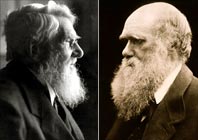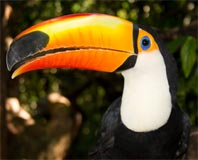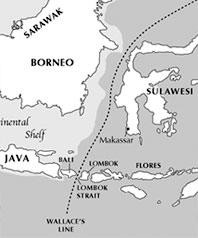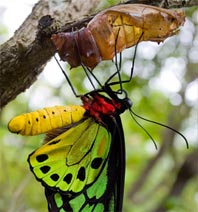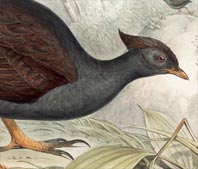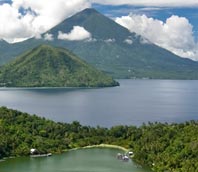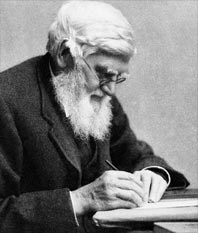Great Minds Think Alike:
How Alfred Wallace Came to Share
Darwin's Revolutionary Insight
by Sean B. Carroll
Parallel tracks
The search for the origins of species, both in general and of
specific kinds of creatures, has entailed a series of truly
epic adventures over the past 200 years. Throughout 2009, the
200th anniversary of the birth of Charles Darwin, the world is
marking the achievements of our greatest naturalist and the
leader of a far-reaching scientific revolution.
Darwin's great voyage and works are well known, and rightly
so. But the making of the theory of evolution and its early
growth and acceptance also owe a considerable debt to Alfred
Russel Wallace, who undertook two long voyages under yet more
difficult conditions, and independently reached very similar
conclusions to Darwin.
Wallace's dramatic story and scientific contributions are
generally much less well known. The writer C.W. Ceram
described adventure as "a mixture of spirit and deed," and I
think no naturalist's experiences better fit that definition
than Alfred Wallace's. I will highlight some of his adventures
and discoveries, show how he developed similar ideas as
Darwin, and offer a glimpse into the very warm relationship
that emerged between the two great naturalists.
The two men had a number of traits in common. Both were eager
to escape England and to explore the glories of the Tropics.
Both did so as young men—Darwin was 22 when he boarded
the HMS Beagle, and Wallace was 25 when he first left
England. Above all, they were each prodigious collectors, and
through collecting they developed an appreciation for the
variety each species exhibited. From this very hard-earned
knowledge, they evolved from collectors into scientists, who
asked not just what creatures existed in a given place but how
they came to be, and these questions led each man to unique
and shared discoveries.
Deep into Amazonia
In 1847, Wallace proposed to his friend and fellow collector
Henry Walter Bates that they travel to the Amazon. His
principal motivation was to build a personal natural history
collection. But Wallace was also well-read on scientific
topics of the day. Unlike Darwin, who did not set out with any
intent of gathering evidence for or against any great idea,
Wallace suggested to Bates that on their journey they could
"gather facts toward solving the problem of the origin of
species." That problem, circa 1847, pivoted on a potent
question: Were species immutable and specially created by God,
or changeable and the product of natural processes?
Wallace and Bates were self-taught amateurs who did not have
the family financial resources that Darwin had, or the
connections with academia, or berths on a British naval
vessel. They had to make their way to the Amazon on a
commercial trading ship and then cover their expenses by
shipping prized specimens back to England for sale.
They arrived in Para on the northeast coast of Brazil in May
1848. After a time exploring the region they split up, with
Wallace heading up the main trunk of the Amazon and then up
the Rio Negro and its largest branch, the Rio dos Uaupés.
By 1852, after four years of arduous travel and collecting, he
was 2,000 miles upriver from the Atlantic Ocean, farther than
any European had ever gone.
But he was spent. Physical exertion, poor nutrition, and
tropical diseases had weakened him to a state in which he
feared that if he did not turn back he would die in the
jungle. In addition to many preserved specimens that he had
with him and stored downriver, Wallace had accumulated a large
menagerie of live animals—monkeys, macaws, parrots, and
a toucan—that he hoped to take all the way to the London
Zoo. Their upkeep was draining him of what little energy he
had remaining.
Wallace headed back downriver to Para. He found a ship headed
for England, the brig Helen, boarded it with 34 live
animals and many boxes of specimens and notes, and set sail
for home.
Lost at sea
Four weeks into the journey and about 700 miles east of
Bermuda, the Captain came to Wallace's cabin and said, "I'm
afraid the ship's on fire; come and see what you think of it."
Wallace followed the Captain to the hold and saw smoke pouring
out of it.
The crew could not douse the smoldering blaze. The Captain
ordered down the lifeboats. Wallace went to his hot, smoky
cabin and salvaged a small tin box and threw in some drawings,
some notes, and a diary. He grabbed a line to lower himself
into a lifeboat, slipped, and seared his hands on the rope.
His pain was compounded when his injured hands hit the
saltwater. Once in the lifeboat, he discovered it was leaking.
Wallace watched his animals perish and the Helen burn,
along with all of his specimens.
"And now everything was gone, and I had not one specimen to
illustrate the unknown lands I had trod..."
And so there he was, lying on his back in a leaky lifeboat in
the middle of the Atlantic. Day after day passed in the open
boats. Wallace was blistered by sunburn, parched with thirst,
soaked by sea spray, exhausted from constantly bailing water,
and near starvation. At last, on the tenth day, they were
picked up.
Aboard his rescue ship, Wallace began a letter to a friend in
Brazil detailing his ordeal and the magnitude of his loss:
"How many weary days and weeks had I passed, upheld only by
the fond hope of bringing home many new and beautiful forms
from those wild regions; every one of which would be endeared
to me by the recollections they would call up... And now
everything was gone, and I had not one specimen to illustrate
the unknown lands I had trod...."
Wallace wrote to his friend that "fifty times" on the voyage
home he had sworn to himself "if I once reached England, never
to trust myself more on the ocean." If he had held to that
promise, his story would end here and few would have ever
heard of Alfred Wallace again. But, as he wrote to his friend,
"good resolutions soon fade...." Wallace decided that, despite
his loss and near death, he would voyage again.
To the Malay Archipelago
Wallace's lust for exploration and collecting was not
satisfied, nor was his interest in the origin of species. That
mystery was still unsolved as far as the scientific world knew
in 1852. Though Darwin had reached his conclusions many years
earlier, his ideas were known to only a few intimates, and
Wallace was not one of them.
Wallace began to ponder his next destination. He had to
collect quarry that would fetch good prices, but he ruled out
a return to the Amazon. He began thinking about the Malay
Archipelago, the vast group of islands between Southeast Asia
and Australia (see map). Other than those on the island of
Java, the animals and plants of the region were unknown.
Enough fragments of natural history were emerging from the
Dutch settlements there to convince Wallace that it offered
both rich pickings and good facilities for a traveler.
The islands span more than 4,000 miles from east to west and
1,300 miles from north to south, an area almost as large as
the entire continent of South America. Covered in tropical
forest, the islands might appear similar, but some held
different treasures, and discovering and explaining the
differences would put Wallace, literally, on the map.
Wallace arrived in Singapore in April 1854 and set out to
explore the country. He would encounter altogether different
treasures, and dangers, than those on the Amazon. For example,
there were tigers roaming about Singapore; they killed on
average one resident a day. Wallace occasionally heard their
roars, and in typical British understatement he noted that "it
was rather nervous work hunting for insects ... when one of
these savage animals might be lurking close by..."
Germinating ideas
Unflustered by such concerns, Wallace followed a daily
routine. Up at 5:30 a.m., he started the day with a cold bath
and hot coffee. He sorted out the previous day's collection
and then set out again into the forest with his gear. He
carried a net, a large collecting box hung on a strap over his
shoulder, pliers for handling bees and wasps, and two sizes of
specimen bottles for large and small insects, attached by
strings around his neck and plugged with corks. On some days,
he carried a rifle.
"I naturally expected to meet with some of these birds again;
but during a stay there of three months I never saw one of
them..."
Despite some reputation for ferocity, the native tribesmen in
parts of the archipelago he visited shared their knowledge of
the forest with Wallace and helped him to find what he was
after. He stalked the islands' most beautiful and prized
natural riches—orangutans, monkeys, spectacular birds of
paradise, and enormous, brilliantly colored butterflies.
Wallace mused that:
"Nature seems to have taken every precaution that these, her
choicest treasures, may not lose value by being too easily
obtained. First, we find an open harbourless, inhospitable
coast, exposed to the full swell of the Pacific Ocean; next, a
rugged and mountainous country, covered with dense forests,
offering [in] its swamps and precipices and serrated ridges an
almost impossible barrier to the central regions; and lastly,
a race of the most savage and ruthless character...."
Wallace was paying close attention to the diversity of species
he found, the variety among the individuals of each species,
and where he found them. These were the practical
concerns of a paid collector but also the catalysts of his
transformation into a scientist.
For example, while pursuing beautiful birdwing butterflies,
which were coveted for their large wingspan and rich
coloration, Wallace noticed that different birdwing types were
restricted to particular islands. These butterflies signaled
to him just what the birds of the Galapagos archipelago
signaled to Darwin—that species change.
While Darwin was keeping quiet about evolution, Wallace was
thinking out loud, putting his thoughts on paper and firing
them off to magazines and journals in England. Some of these
were short field notes; others revealed bigger ideas. But
Wallace had none of the concerns that restrained Darwin. He
had a reputation to make, and nothing to lose.
A law of nature
In 1855, while waiting out the wet season in Sarawak, on
Borneo, Wallace wove together threads of geology and natural
history to propose a new law:
Every species has come into existence coincident both in
space and time with a pre-existing closely allied
species.
Wallace thought that species were connected like "a branching
tree." He was proposing that new species come from old species
as new twigs grow from older branches. This bold idea refuted
the then-dominant doctrine of special creation—that each
species was specially created, in one moment, to fit the land
it inhabited. Moreover, Wallace used some of the very
arguments that Darwin had agonized over for almost two decades
but had not yet published.
Wallace supported his "Sarawak Law" with all sorts of
observations on the distribution of species, especially those
on islands. For example, the Galapagos, he wrote, "which
contain little groups of plants and animals peculiar to
themselves, but most nearly allied to those of South America,
have not hitherto received any, even a conjectural
explanation." Wallace was referring to Darwin's observations,
which had not been explained.
Wallace pointed out that families of butterflies, birds, and
various plants are confined to certain regions. He had noticed
when he was in the Amazon that some species of monkeys were
confined to one side of the river. "They could not be as they
are," he wrote, "had no law regulated their creation and
dispersion." By "dispersion," Wallace meant that the extent to
which a species could spread out over the land was constrained
by features of the land—rivers, mountain ranges, and so
forth.
Almost no one read or noticed the paper when it first
appeared. Wallace heard nothing from England about his Law,
except for some grumblings that he should focus on collecting
and not theorizing.
Drawing a line
Wallace went island-hopping quite often. He made 96 journeys
totaling about 14,000 miles and visited some of the same
islands several times over the span of eight years. Often the
availability, or unavailability, of a boat determined his
path. One day in May 1856, he took a Chinese schooner from
Singapore to Bali, which he had no intention of visiting, but
he figured he could find a way from there to Lombok and then
on to Makassar on the island of Sulawesi. This accidental
detour would give Wallace the most important discovery of his
expedition.
On Bali, Wallace found kinds of birds as on the other islands
he had visited to the west, including a weaver, a woodpecker,
a thrush, a starling—nothing too exciting. But then,
"crossing over to Lombok, separated from Bali by a strait less
than twenty miles wide, I naturally expected to meet with some
of these birds again; but during a stay there of three months
I never saw one of them...." Instead, Wallace found a
completely different assortment: white cockatoos, three
species of honey-suckers, a loud bird the locals called a
"Quaich-Quaich," and a really strange bird called a megapode
("big foot") that used its big feet to make very large mounds
for its eggs. None of these groups were known on the western
islands of Java, Sumatra, or Borneo.
Now here was a puzzle. What constraint prevented the spread of
these species from island to island? Surely, birds could cover
a 20-mile strait with little trouble.
"The life of wild animals is a struggle for existence."
Wallace described the mystery in a letter to Bates. He
theorized that there was some kind of invisible "boundary
line" between Bali and Lombok. Traveling farther east to
Flores and Timor, the Aru Islands, and New Guinea, the
changeover in bird life was very clear. All the families of
birds that were common on Sumatra, Java, and Borneo were
absent from Aru, New Guinea, or Australia, and vice versa. The
differences in mammals among the western and eastern islands
were just as striking. On the large western islands there were
monkeys, tigers, and rhinoceri. But on Aru there were no
primates or carnivores. All the native mammals were
marsupials—kangaroos, cuscus, and the like.
That line between Bali and Lombok was real, and it signified
something very profound to Wallace. He put his thoughts to
paper again. Wallace pointed out that under the doctrine of
special creation, one would expect to find similar animals in
countries with similar climates, and dissimilar animals in
countries with dissimilar climates. This is not at all what he
saw.
Comparing Borneo (in the west) and New Guinea (in the east),
he wrote, "[I]t would be difficult to point out two [lands]
more exactly resembling each other in climate and physical
features." But their birds and mammals were entirely
different. Comparing New Guinea and Australia, he wrote, "we
can scarcely find a stronger contrast than in their physical
conditions ... the one enjoying perpetual moisture, the other
with alternations of excessive drought." Wallace reasoned, "If
kangaroos are especially adapted to the dry plains and open
woods of Australia, there must be some other reason for their
introduction into the dense damp forests of New Guinea...." In
the tropical forests of the eastern islands, tree kangaroos
occupied the habitat occupied by monkeys in the west.
Wallace reasoned further that "some other law has regulated
the distribution of existing species." That law, Wallace
suggested, was the "Sarawak Law" he had proposed two years
earlier. Again Wallace relied on geology to make his case. He
surmised that New Guinea, Australia, and Aru must have been
connected at some time in the past and so share similar sets
of birds and mammals. Similarly, Wallace deduced that the
western islands had once been part of Asia and so share the
fauna of tropical Asia—monkeys, tigers, etc.
Wallace was right. He had linked the question of the origin of
species to how species were distributed, and he had defined a
dividing line between the fauna of Asia and Australia. His
discovery would forever after be known as the "Wallace Line"
and Wallace himself as the founder of biogeography, the
science dealing with the geographical distribution of plants
and animals.
Meeting of the minds
For Wallace the question, then, was not if species evolved but
how? Baking in a malarial fever on the volcanic island of
Ternate in early 1858, the answers came to him.
Alternating between hot and cold fits, Wallace had nothing to
do but "think over subjects then particularly interesting to
me." Wrapped in a blanket on a 88°F day, he thought of the
English economist Thomas Malthus's essay on population, which
he had read some years earlier. It occurred to him that the
diseases, accidents, and famine that Malthus argued check the
growth of human populations act on animals, too. He thought
about how animals breed much more rapidly than humans and, if
left unchecked, would overcrowd the world very quickly. But
all of his experience revealed that animal populations were
limited. "The life of wild animals is," Wallace concluded,
"a struggle for existence" [my italics—watch
for more below, and for why I highlight them]. Wallace
continued: "The full exertion of all their faculties and all
their energies is required to preserve their own existence and
provide for that of their infant offspring." Finding food and
escaping danger ruled animal lives, and the weakest would be
weeded out.
Wallace the great collector was intimately familiar with the
variety of individuals of a species. "Perhaps all the
variations ... must have some definite effect,
however slight, in the habits of or capacities of the
individuals ... a variety having slightly increased powers ...
must inevitably acquire a superiority in numbers."
"I know not how or to whom to express fully my admiration of
Darwin's book."
Wallace wrote the paper out in its entirety in just a few
nights. He entitled it "On the Tendency of Varieties to Depart
Indefinitely From the Original Type." Wallace's paper was just
a sketch, conceived in a dilapidated house on an
earthquake-ravaged island during bouts of fever, 10,000 miles
from the center of science in England. Wallace did not send it
directly to a journal; he wanted others to look at it first.
So he sent it to a naturalist with whom he had begun a
correspondence—Charles Darwin.
Darwin received Wallace's paper sometime in June 1858. He was
shocked when he read it. The reason for that shock is
especially clear when one considers what Darwin had recently
written in drafts of two chapters for a large book he was
working on and compares it with the language of Wallace's
paper.
In February 1857, Darwin had composed Chapter 5 of his book
and entitled it "The Struggle for Existence as
Bearing on Natural Selection" [again, my italics]. The next
month he had completed Chapter 6, in which he explained that:
"All Nature ... is at war. ... The struggle very often falls
on the egg & seed, or on the seedling... any
variation, however infinitely slight, if it
did promote during any part of life even in the slightest
degree, the welfare of the being, such variation would tend to
be preserved or selected."
Neither author was aware of the other's thoughts and writing.
How can we explain the remarkable similarities in
language—"the struggle for existence" and "slight
variation"?
Great minds think alike.
Both men had seen nature up close and understood it was a
battlefield. Both men had collected enough specimens of
individual species to appreciate that species were variable.
Both men had seen slightly different species restricted to
particular islands and concluded that species change. Both men
had read and recognized the relevance of Malthus's essay on
populations. Confronted with similar evidence, they had
reached very similar conclusions.
Nonetheless, Darwin, more than 20 years after his first
insights into species formation, feared that "all of my
originality, whatever it may amount to, will be smashed."
"A little proud"
What happened thereafter is still a subject of debate among
scholars. The facts are that Wallace had asked Darwin to
forward the manuscript to the geologist Sir Charles Lyell,
which Darwin did. Lyell and J.D. Hooker, the eminent botanist,
were intimates of Darwin, to whom he had divulged his theory
of natural selection and much of the argument supporting it.
Lyell and Hooker took the initiative to arrange for Wallace's
paper, and a brief sketch from Darwin on his theory, to be
read together at an upcoming meeting of the Linnaean Society
and to be published together.
Was Wallace robbed of his individual right to glory? Was the
arrangement of joint publication fair? (Wallace was not
informed of it until after the fact.) It was Darwin who had
coined the term "natural selection," and he had shared his
1842 sketch, at least privately, with other scientists.
It is true that Darwin's name and works are far better known
than Wallace's today. But consider Wallace's perspective on
the matter. While still in the Malay Archipelago, he received
a copy of the Origin of Species from Darwin. He
read it over and over. Then he disclosed his reactions in a
private letter to his longtime friend Bates:
"I know not how or to whom to express fully my admiration of
Darwin's book. ...I do honestly believe that with however much
patience I had worked up & experimented on the subject I
could never have approached the completeness of the
book,—its overwhelming argument, & its admirable
tone & spirit. ... Mr. Darwin has created a new science
& a new Philosophy, & I believe that never has such a
complete illustration of a branch of human knowledge, been due
to the labours and researches of a single man."
Not in this letter nor for the rest of his long life—he
lived to 90—did Wallace utter a word of regret, envy, or
resentment.
Perhaps for Wallace it was simply a matter of being accepted.
He was, up until 1858, an outsider to the circle of eminent
scientists who led the new revolution in thought. When he
heard that Lyell and Hooker had made complimentary remarks
about his paper, he wrote his oldest friend and school-fellow
that "I am a little proud...." Wallace did not need
or seek to be the center of the circle; he just wanted to be
let inside. That, and more, he surely earned.
